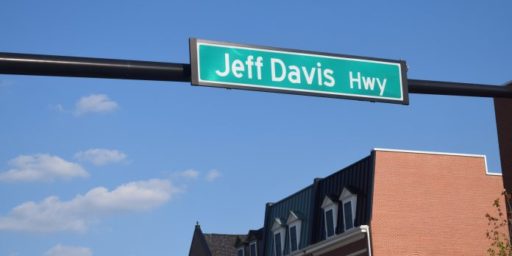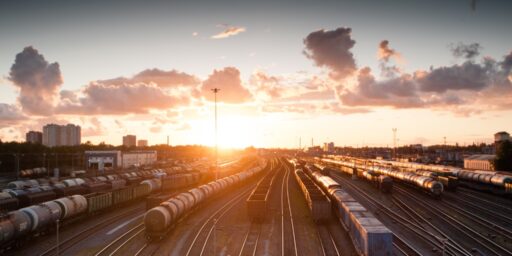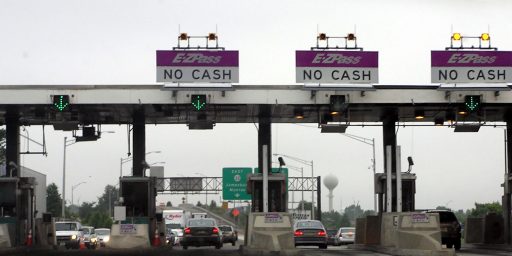Trucks-Only Roads
WaPo: Safety, Va. Scenery at Issue In Push for Trucks-Only Road
Those forces have converged in the mountains and valleys of western Virginia, where, all day and all night, the couriers of American commerce curl along I-81. Tractor-trailers dominate what has become known as the “NAFTA Highway” and move through like a rolling market of the nation’s products and services — Bud Light, Serta, Flav-O-Rich, FedEx. More than a few of the rigs cough gray-black smoke into the air that colors the Blue Ridge.
What ultimately happens here will have profound implications for one of Virginia’s most treasured landscapes, truck traffic in the Washington region and how goods are moved across the nation in the coming decades.
If a truck-only highway goes forward, it will mark a fundamental shift for an interstate system originally built to connect America to itself, not solely to facilitate the movement of goods.
“The emphasis for the last 50 years or so was to build a highway system to serve both autos and freight, and as you look out 50 years, those may not always be compatible,” said Pierce R. Homer, Virginia’s deputy transportation secretary and the head of a panel that picked the “truckway” solution for I-81. “It’s no longer just a part of creating linkages among communities. It’s about managing the movement of commodities in the 21st century. It’s a very, very big deal.”
***
This is its appeal to freight haulers. It provides a straight, toll-free shot from the south through the mid-Atlantic and northeast. The interstate also bypasses the traffic of most major cities but runs close enough to them that truckers can take a quick turn onto other highways and motor directly to population centers.
***
The new roadway that would address these issues would be built by a private consortium called Safer Transport and Roadways (STAR) Solutions, whose $6.4 billion plan calls for doubling I-81 within 15 years with a combination of federal, state and private funds and a proposal to charge tolls. STAR and state officials are negotiating the terms of a contract, and if an agreement can be reached, no other approvals are needed.
This is an interesting idea. Still, it seems like an expensive way to solve the myriad of problems that come when 18-wheelers and 4-wheelers share the same road. A more sensible solution would be to restrict the freight haulers to the rightmost lane and/or to limit them to off-peak hours as is quite common in Europe.






Limit them to off peak hours?
LOL… methinks you do too much beltway driving James. Try I-90 between Chicago and New York City, and you’ll quickly realize that a) the right lane is already the lane of choice, but that trucks must constantly use the left to pass, and b) the only non-peak hours are between 1 am and 5 am.
Whoops – typo – I-80
Most places I’ve driven trucks are in all lanes, including side by side blocking all traffic. I’d forbid them from going into other lanes to pass; they invariably clog traffic for cars when they do it.
Clearly, there are major cities where there is nearly round-the-clock traffic. Still, having trucks on the road from only, say, 7 pm to 7 am, would radically reduce congestion.
I’m not sure if they still do it, but years ago Germany controlled truck traffic by issuing them “credits” for when they could be on the road. Some trucks were on the road all the time, but the peak truck traffic was later in the evening. They did the same thing with military convoys, incidentally. We often had to kill several hours between finishing an exercise and convoying back to the home base. But it spared commuters from having to work around 40 mph convoys traveling down the road.
Most places I’ve driven trucks are in all lanes, including side by side blocking all traffic. I’d forbid them from going into other lanes to pass; they invariably clog traffic for cars when they do it.
Clearly, there are major cities where there is nearly round-the-clock traffic. Still, having trucks on the road from only, say, 7 pm to 7 am, would radically reduce congestion.
I’m not sure if they still do it, but years ago Germany controlled truck traffic by issuing them “credits” for when they could be on the road. Some trucks were on the road all the time, but the peak truck traffic was later in the evening. They did the same thing with military convoys, incidentally. We often had to kill several hours between finishing an exercise and convoying back to the home base. But it spared commuters from having to work around 40 mph convoys traveling down the road.
It seems the most logical method is keeping trucks on the right hand side except when passing. It has been quite a while since I have been on I-81; if I remember it is only a two lanes in each direction right?
A Few points:
Putting all the trucks in the right lane is a real good way to destroy the right lane and have to repave it 3 times faster causing even more traffic.
Further, this is a problem of bandwidth. We don’t have enough. Keeping them in one lane and only at night will only exacerbate the problem.
The “market” keeps them moving mostly at night already, no “credits” needed.
While the price seems high, you also have to deduct the money that is NOT spent to expand/repave the passenger roads. Not to mention fuel efficiency and safety costs.
This is a FAR better use of money than the stupid HOV lanes that litter the country and never get used.
James, while it’s not a perfect analogy, youre problems with truck traffic remind me a bit of the people who purchase hobby farms, then petition the municipality to get rid of the pig barn on the neighboring land, because they find the smell disagreeable.
Trucks are the arteries of the US economy. Every solution has its drawbacks – currently, they can carry only 2/3 (I believe) of the weight that Canadian trucks can, but increase weights and you’ll increase stopping distances (more serious accidents) and cause more costly road damage. Road damage requires repair, which slows the very traffic you complain about.
You’re not the first one I’ve heard complain about trucks, their danger, their inconvenience. You’d think that the CD players and plasma tvs simply materialize in the Sears home entertainment department…..
Kate,
I’m not advocating banning trucks, simply figuring out how best to make them co-exist with cars on inadequate roads. Trucks are indispensible to our economic system but also dangerous. If we put them on the road at times when fewer cars are out there, everybody wins–we maximize the use of a scarce resource.
We use to have a fantastic “trucks only” road. It was call The RailRoad system. But the President of GM decided what was good for GM was good for America and pretty much did the railroads in.
Maybe the highways wouldn’t be clogged with trucks if we invested more in schedule freight….but then that creates two new problems….
We do we do with all those CW truck driv’n tunes and what happens to all those truck stops and bubble gum chewing waitresses?
I guess its true, there are no free lunches
Delta Dave,
At last I checked, the railroads are enjoying record profitability and are carrying more cargo than ever. Yeah, they’ve been done in.
James,
It really doesn’t sound like you’ve driven many rural interstate miles lately. I drove 81 from Scranton, PA to Abingdon, VA and back last May, and there was just a massive number of trucks, and it was almost all just two lanes.
You can have those rules about trucking in Europe because most inter-city routes in Europe are fairly short. Tractor trailers in this country are usually much bigger than European ones because American ones have sleeping quarters for cross-country trips that take several days. Only allowing trucks to go at night would probably eliminate the interstate trucking industry in this country, which would make it well-night impossible to transport goods in many parts of the country.
I don’t know whether the all-truck roads would be any better, but expanding all the rural interstates to three lanes would cost a lot too, and not have as many benefits.
John,
Theoretically, truckers are limited to, what, 12 hours a day? So, put most of them on the road during off-peak hours.
A couple of points.
First, I suspect that would make the roads much more dangerous for cars at night. Some trucks already do go at night, but putting them all out there at the same time with their lights blinding any car drivers would not help.
Second, from what I can tell about people I’ve known who work night shifts, it’s not natural to sleep during the day and come out at night, and people who work night shifts typically suffer from much more fatigue. Since fatigue apparently causes more accidents than drinking, this would further make the roads less safe at night.
Even if most people drive during peak hours, the peak effect is much weaker on rural interstates, and I can’t imagine that the net effect of such a system would lead to fewer highway fatalities.
—